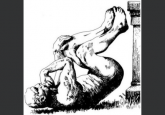Scientists just want to have fun: the 33rd First Annual Ig Nobel Prizes

From musical interludes (including a Mini-Non-Opera about water) to silly science, this year’s Ig Nobel Prize ceremony was packed with educational entertainment, which was truly hilarious.
The 33rd First Annual Ig Nobel Prize ceremony was held online on 14 September 2023, and it certainly did not disappoint. I initially had no intention of watching the whole ceremony, but ended up staying for the hilarious onscreen antics, an incredible array of hats and the impressive amount of accordion played throughout the ceremony. Having never watched the Ig Nobel Prize ceremony before, it was full of surprising moments that I just had to screenshot and send to a friend. I’m not sure words can capture all that went on throughout the ceremony.
But, of course, it’s not only a show for entertainment but also an award ceremony to ‘honor achievements that first make people laugh, and then make them think’. Here are just a few of the awards presented during the ceremony.
Why do scientists lick rocks?
The Chemistry and Geology award went to Jan Zalasiewicz (University of Leicester, UK) for his essay explaining why scientists lick rocks – a rumor that I’ve heard over the years. Jan explains, and demonstrates, that it is much easier to see details on the wet surface of a rock than on a dry surface (meaning, on a rainy day, no rocks need to be licked). The history of licking rocks goes back centuries; Jan says that 200 years ago, scientists would lick rocks to identify them. He gave the example of Giovanni Arduino (1714–1795), an early geologist, who would lick rocks to tell them apart and described their taste in great detail like, “ashes from a shelly mudstone tastes like fire and leaves a certain sweetness.”
Creating a dextrous claw from dead spiders
Te Faye Yap, Zhen Liu, Anoop Rajappan, Trevor Shimokusu and Daniel Preston (Rice University, TX, USA) were awarded the Mechanical Engineering Prize for reanimating dead spiders to use as mechanical gripping tools. If you examine a dead spider (before hoovering it up), you’ll notice that their legs are curled up. This is because spiders only have flexor muscles, which decrease the angle around a joint, and use hydraulic pressure instead of muscles to extend their legs outwards. The researchers tapped into the hydraulic system of dead spiders to extend their legs, creating a claw machine they’ve called ‘necrobotics’. These necrobotics can pick up delicate objects and even things that are heavier than themselves. “We hope that this new field of necrobotics will inspire curiosity-driven research and spark ideas for how we can respectfully and sustainably use biotic materials for robotic application,” Te says.
“Don’t waste your waste”
Seung-min Park (Stanford University School of Medicine, CA, USA) was awarded the Public Health Prize for inventing the Stanford Toilet, which monitors and analyzes substances that humans excrete. This is no ordinary toilet and is kitted out with a urinalysis dipstick test strip, a computer vision system for defecation analysis, an anal-print sensor paired with an identification camera and a telecommunications link. Seung-min explained this toilet is an example of how hygiene practices can be transformed into healthcare; however, he does acknowledge the potential privacy concerns of this toilet, given that it passively collects data and sends it for analysis. I wonder if, one day, we’ll see these types of smart toilets in the houses of the rich and famous.
Learning about the brain by speaking backwards
María José Torres-Prioris, Diana López-Barroso, Estela Càmara, Sol Fittipaldi, Lucas Sedeño, Agustín Ibáñez, Marcelo Berthier and Adolfo García (a collaboration across research institutions in Spain and Argentina) won the Communication Prize for their work studying the brain activity of those who are experts at speaking backward. They’re using this unusual (and mind-blowing) ability to understand how our brains arrange phonemes, single sounds that are the building blocks of speech.
How many nose hairs do we have?
The Medicine Prize was awarded to Christine Pham, Bobak Hedayati, Kiana Hashemi, Ella Csuka, Tiana Mamaghani, Margit Juhasz, Jamie Wikenheiser and Natasha Mesinkovska (University of California, CA, USA) for using cadavers to explore if each nostril has the same number of nose hairs. As trivial as this sounds, nose hairs are an important part of our body’s defense system against getting sick. Natasha and her team study alopecia and noticed a lack of quantitative information about nose hair, leaving them wondering: How many nose hairs do we have? How far up our nostrils do they grow?
To find out, they examined nose hairs in 20 cadavers, counting an average of 120 hairs in the left nostril and 112 in the right. They also found most of the nose hairs grew 1cm up into the nostril.
“Have you ever tried to lick a battery?”
“Have you ever tried to lick a battery?” asked Homei Miyashita, who, along with Hiromi Nakamura (Meiji University, Tokyo, Japan), was awarded the Nutrition Prize for their research investigating how electrical stimulation alters the taste of food. The pair created electrical chopsticks and drinking straws, which augment the taste of food, giving them an enhanced salty flavor.
Take a look at the rest of the awards presented during the ceremony here.




